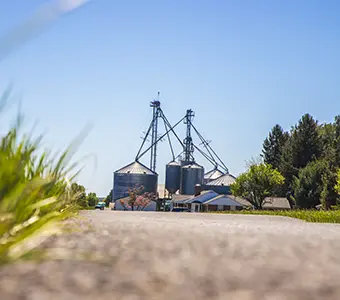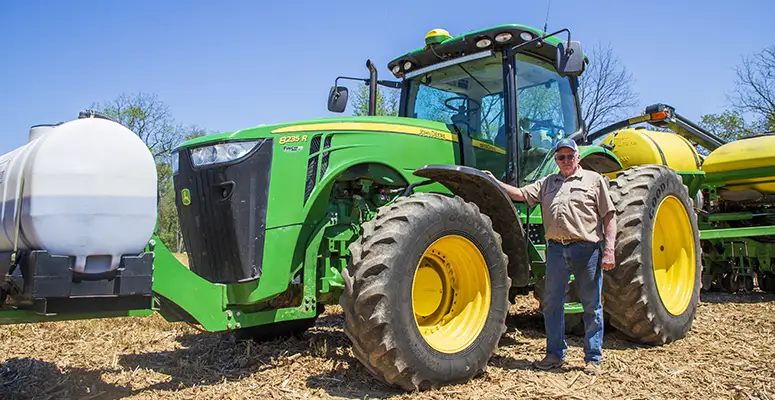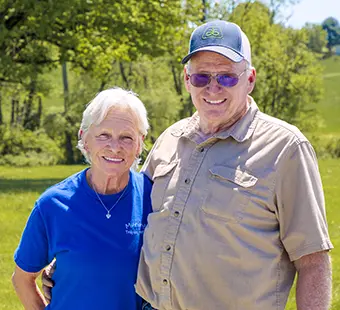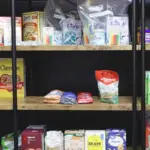by Lois Szymanski, photography by Nikola Tzenov
Donald Maring of Woodbine is up before sunrise and works outside until dark most days. He is doing what his family has done for generations — it’s in his blood.
“My family has always farmed,” the 71-year-old Maring says. His grandparents on both sides were farmers. “My grandfather started farming in Woodbine in 1910 on a farm my cousin still owns. My dad purchased the current farm in 1949. Growing up, the whole family worked together on this farm.” They had a dairy operation for a while, then beef cattle. As kids, he and his siblings showed beef cattle every year at the county fair. But he was always more interested in crops, he says. In 1995, Maring took over all the farming.
“My brother and sisters and I own 105 acres here that we purchased together. It was a farm that came up for sale and adjoined the current family farm of 80 acres. I own another 97 acres across the road,” he says.
He now farms a total of 1,300 acres. Last year, he planted 550 acres of corn, 590 acres of soybeans, 100 acres of wheat, 70 acres of orchard grass hay and 15 acres of alfalfa. He plans to plant a little more hay and soybeans this year.
Over the years, Maring says he’s seen changes in agriculture and has adapted to prosper.
“It has gotten more expensive to lease ground,” he says. “It used to be landowners just hoped to get their real estate taxes out of the rent. Now, the money more than covers the taxes. You have to have a large number of acres to justify the cost of the equipment you need these days.”
For example, the combine he purchased the fall before last year cost $770,000. It’s one of 30 to 40 pieces of equipment he owns and the most expensive.
“Tractors that cost $100,000 15 years ago are now over $200,000 or more,” he states. He still owns the first tractor he purchased in 1990, a John Deere.
His voice grew nostalgic when speaking about his mom, who passed away last year at the age of 93.

“My parents both grew up working horses on the farm. Before she passed, she got to ride in the new combine that steers itself. She was amazed. You have to turn it around on the ends, but then you hit a button, and it takes over, working off satellite,” he notes.
Hard work and adaptability are important in farming, but adapting to technology was a new challenge. In 2015, Maring bought an iPad to plug into the planter he purchased.
“That’s when I switched from a flip phone to an iPhone, too,” he said with a smile. “The iPad records everything we do. I get my yield information, when we planted, what day, what variety, the population planted. You can even look back and see the speed at which you planted and how thick you planted. The computer in the tractor collects the data, then the iPad records everything.”
Maring recalled when his dad started no-till planting in the mid ’70s, a practice he still employs. He’s seen dramatic advancements in seed technology, and genetically modified seeds now increase yield potential.
“As hot and dry as it was these last two years, with little rain, I think everyone had better yields than they ever expected. Twenty years ago, that would have been pretty decimating to most farmers,” he says.
Maring says the market plays an essential role in choosing what to grow. Hay is the most profitable crop, but depending on the weather, it can be a gamble.
“If it gets rained on, it loses value, and it’s not worth it,” he says. Soybeans are a safer bet. “I now grow Plenish soybeans, which have high oleic oil. High oleic oil is better for cooking. It has no trans fats when it’s processed. I’ll plant about 700 acres this year. Depending on the weather, we can average 70 bushels per acre, sometimes more.”
He’s also adopted double-cropping his soybeans. That’s when a new crop is planted on the same land just after harvesting the first crop. Beans are double-cropped after the wheat harvest in late June or early July. To eliminate runoff and erosion, Maring plants cover crops, which helps protect the environment.
In July 2024, this hardworking Carroll County farmer was named the Mid Atlantic Master Farmer of the Year by the Mid Atlantic Master Farmers Association. This national agricultural honors program began in 1927 to foster stewardship and leadership in farming in Virginia, Maryland, Delaware, New Jersey and Pennsylvania.

Maring says the award is based on activity, involvement in agricultural groups and the community, and progress on one’s farm. His friend, Dave Burrier, nominated him.
“I get pretty respectable yields,” he says. “Some of that is because I do a lot of things other farmers might not do because it takes more time.”
Adding fertilizer directly when planting seeds is one of those things.
“This slows you down when planting,” Maring explains. “You spend a lot more time loading fertilizer, but it places the fertilizer within two inches of the seed, which is a lot more efficient than broadcasting across the field.”
The 2024 award was not the only occasion when he has received recognition for his work. In 2014, he received an environmental awareness award from the Carroll County Environmental Advisory Council when he reduced the carbon footprint of his farming operation by installing a 48-kilowatt solar facility on his barn’s roof. It generates nearly 100% of the electricity for his grain dryers and lights in the barn.
A certificate from the state of Maryland signed by Gov. Robert L. Ehrlich Jr. hangs on his wall, recognizing the three-year term he served on the Maryland Agricultural Commission. He’s also been a member of the Maryland Grain Producers Association and was on the board of directors for the State Agricultural Commission for two terms. He’s been on the Soil Conservation Board for more than 20 years, including a term as chairman that ended in March. He’s also joined the board of directors for the Mid Atlantic Master Farmers Association.

To give back to the community, Maring and his wife, Terri, purchase 4-H animals at the Carroll County Fair annually and donate them back to be resold. Proceeds from the sale benefit charity.
“Over the years, we’ve purchased and donated 40 animals,” he says. Those donations went to multiple scholarship programs and the 4-H Therapeutic Riding Program.
In addition to these accomplishments, Maring has been a school bus contractor in Carroll County for 38 years, but farming is his passion. When asked about the state of farming today, he paused.
“If you read some of the national magazines on farming, some of them will tell you the state of farming for the future is not pretty, as far as net income for farmers. My biggest worry is the age of farmers. There aren’t many young people farming these days,” he says.
A 2024 report by Ag Daily backs him up. “Nearly 1.3 million farmers are now at or past the age of retirement. Meanwhile, just 300,000 farmers are under the age of 35,” according to the report.
When asked how long he would continue to farm, Maring didn’t hesitate. “As long as my health allows,” he says. “I get up every day because I love what I do.”
For more information on the Mid-Atlantic Master Farmers Association, visit midatlanticmasterfarmers.wordpress.com or find them on Facebook.









